Leadership and Management in Organizations: ICCR Case Study Analysis
VerifiedAdded on 2023/01/03
|13
|3663
|71
Report
AI Summary
This report provides a detailed analysis of leadership and management within organizations, using the Independent Centre for Clinical Research (ICCR) as a case study. It examines the leadership qualities of Rachel Adams, ICCR's CEO, including empowerment, problem-solving, engagement, transparency, influence, adaptability, innovation, empathy, communication, and continuous learning. The report explores how Rachel Adams' leadership style, influenced by McGregor's Theory Y, has inspired employees and fostered a positive work environment. It also contrasts the roles of managers and leaders, highlighting Rachel's dual role as CEO and president, and discusses the sources of managerial power. The analysis covers issues faced by Rachel in ICCR and concludes with a summary of the key findings, emphasizing the impact of Rachel's leadership on the organization's success.
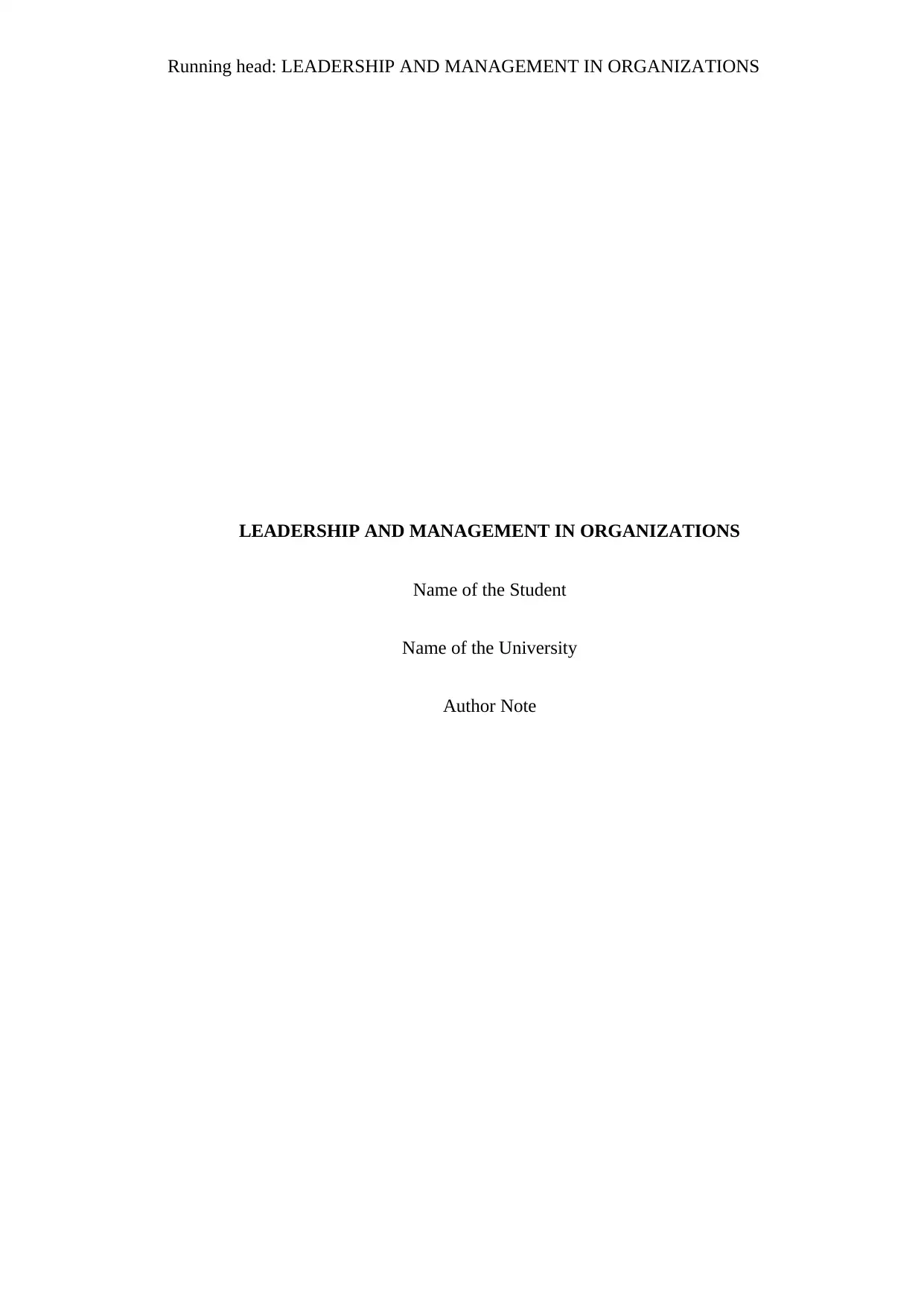
Running head: LEADERSHIP AND MANAGEMENT IN ORGANIZATIONS
LEADERSHIP AND MANAGEMENT IN ORGANIZATIONS
Name of the Student
Name of the University
Author Note
LEADERSHIP AND MANAGEMENT IN ORGANIZATIONS
Name of the Student
Name of the University
Author Note
Paraphrase This Document
Need a fresh take? Get an instant paraphrase of this document with our AI Paraphraser
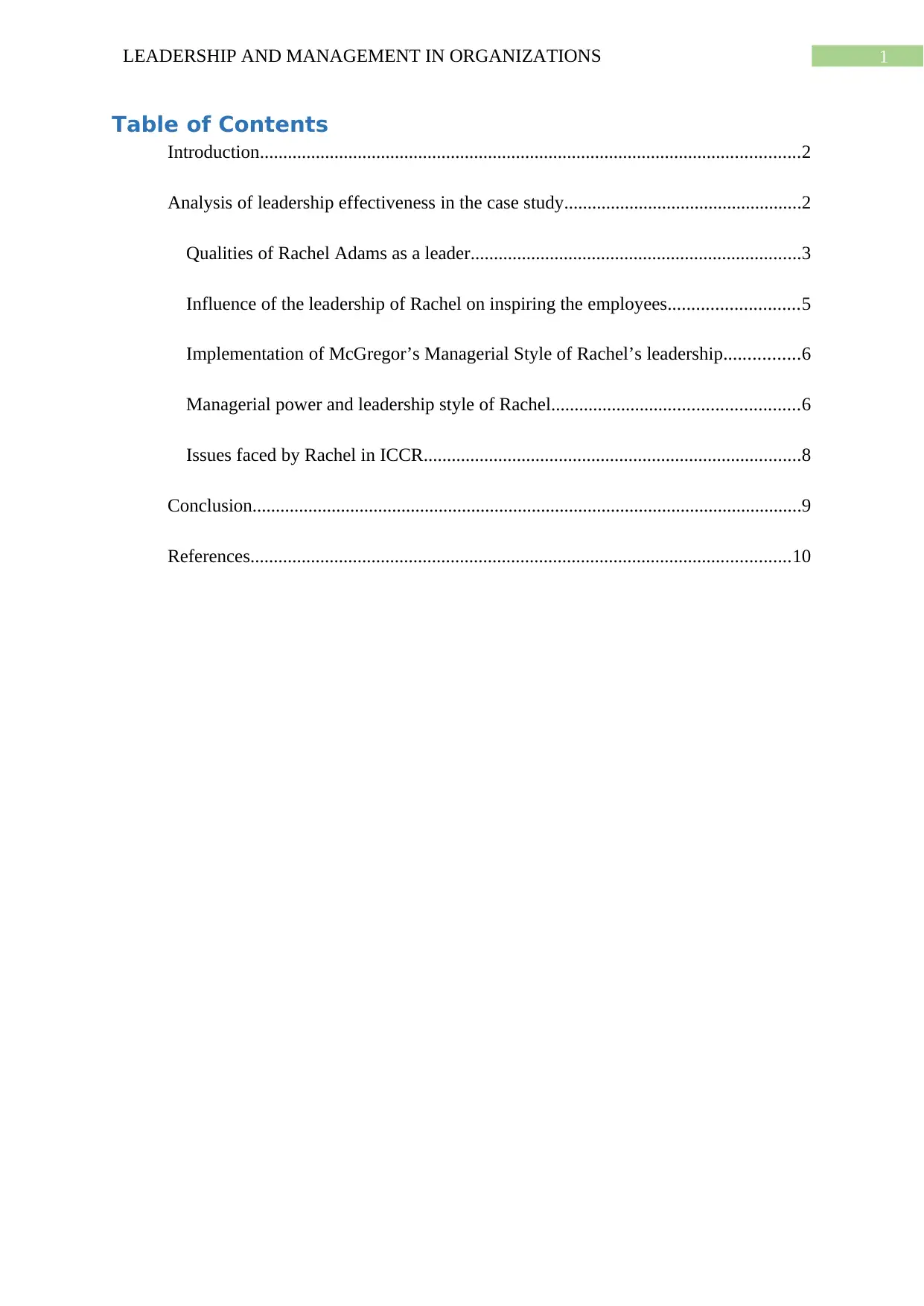
1LEADERSHIP AND MANAGEMENT IN ORGANIZATIONS
Table of Contents
Introduction....................................................................................................................2
Analysis of leadership effectiveness in the case study...................................................2
Qualities of Rachel Adams as a leader.......................................................................3
Influence of the leadership of Rachel on inspiring the employees............................5
Implementation of McGregor’s Managerial Style of Rachel’s leadership................6
Managerial power and leadership style of Rachel.....................................................6
Issues faced by Rachel in ICCR.................................................................................8
Conclusion......................................................................................................................9
References....................................................................................................................10
Table of Contents
Introduction....................................................................................................................2
Analysis of leadership effectiveness in the case study...................................................2
Qualities of Rachel Adams as a leader.......................................................................3
Influence of the leadership of Rachel on inspiring the employees............................5
Implementation of McGregor’s Managerial Style of Rachel’s leadership................6
Managerial power and leadership style of Rachel.....................................................6
Issues faced by Rachel in ICCR.................................................................................8
Conclusion......................................................................................................................9
References....................................................................................................................10
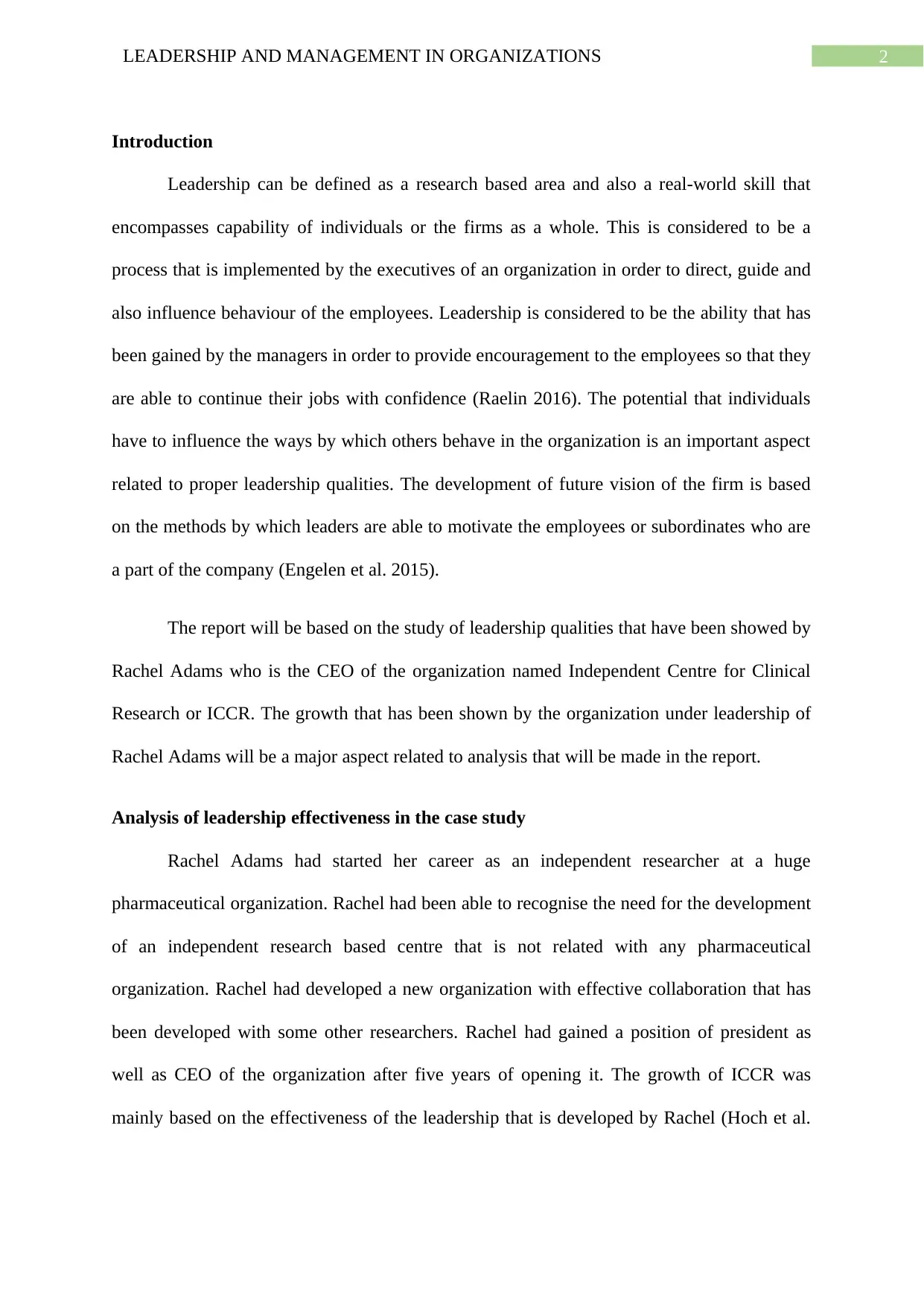
2LEADERSHIP AND MANAGEMENT IN ORGANIZATIONS
Introduction
Leadership can be defined as a research based area and also a real-world skill that
encompasses capability of individuals or the firms as a whole. This is considered to be a
process that is implemented by the executives of an organization in order to direct, guide and
also influence behaviour of the employees. Leadership is considered to be the ability that has
been gained by the managers in order to provide encouragement to the employees so that they
are able to continue their jobs with confidence (Raelin 2016). The potential that individuals
have to influence the ways by which others behave in the organization is an important aspect
related to proper leadership qualities. The development of future vision of the firm is based
on the methods by which leaders are able to motivate the employees or subordinates who are
a part of the company (Engelen et al. 2015).
The report will be based on the study of leadership qualities that have been showed by
Rachel Adams who is the CEO of the organization named Independent Centre for Clinical
Research or ICCR. The growth that has been shown by the organization under leadership of
Rachel Adams will be a major aspect related to analysis that will be made in the report.
Analysis of leadership effectiveness in the case study
Rachel Adams had started her career as an independent researcher at a huge
pharmaceutical organization. Rachel had been able to recognise the need for the development
of an independent research based centre that is not related with any pharmaceutical
organization. Rachel had developed a new organization with effective collaboration that has
been developed with some other researchers. Rachel had gained a position of president as
well as CEO of the organization after five years of opening it. The growth of ICCR was
mainly based on the effectiveness of the leadership that is developed by Rachel (Hoch et al.
Introduction
Leadership can be defined as a research based area and also a real-world skill that
encompasses capability of individuals or the firms as a whole. This is considered to be a
process that is implemented by the executives of an organization in order to direct, guide and
also influence behaviour of the employees. Leadership is considered to be the ability that has
been gained by the managers in order to provide encouragement to the employees so that they
are able to continue their jobs with confidence (Raelin 2016). The potential that individuals
have to influence the ways by which others behave in the organization is an important aspect
related to proper leadership qualities. The development of future vision of the firm is based
on the methods by which leaders are able to motivate the employees or subordinates who are
a part of the company (Engelen et al. 2015).
The report will be based on the study of leadership qualities that have been showed by
Rachel Adams who is the CEO of the organization named Independent Centre for Clinical
Research or ICCR. The growth that has been shown by the organization under leadership of
Rachel Adams will be a major aspect related to analysis that will be made in the report.
Analysis of leadership effectiveness in the case study
Rachel Adams had started her career as an independent researcher at a huge
pharmaceutical organization. Rachel had been able to recognise the need for the development
of an independent research based centre that is not related with any pharmaceutical
organization. Rachel had developed a new organization with effective collaboration that has
been developed with some other researchers. Rachel had gained a position of president as
well as CEO of the organization after five years of opening it. The growth of ICCR was
mainly based on the effectiveness of the leadership that is developed by Rachel (Hoch et al.
⊘ This is a preview!⊘
Do you want full access?
Subscribe today to unlock all pages.

Trusted by 1+ million students worldwide
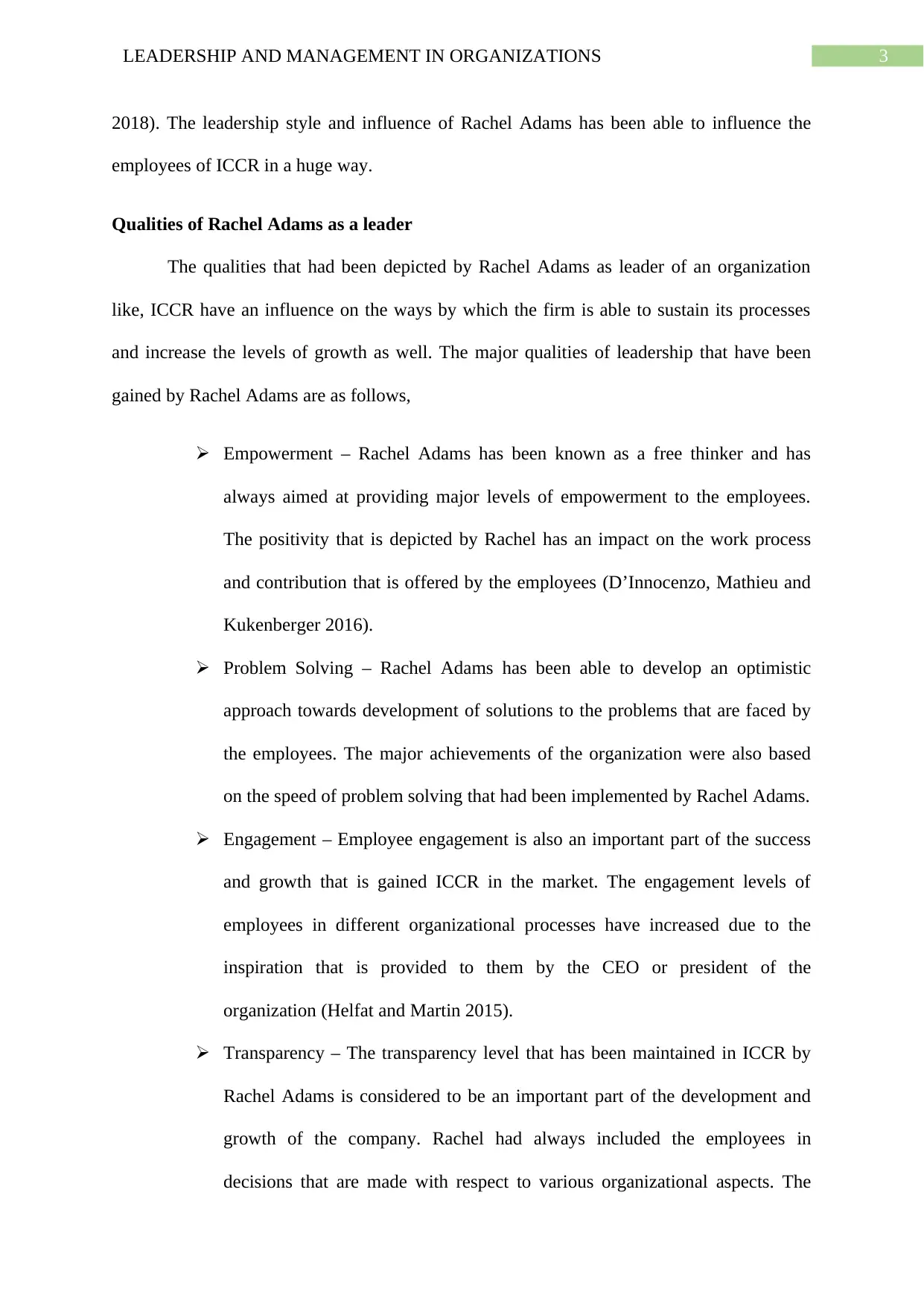
3LEADERSHIP AND MANAGEMENT IN ORGANIZATIONS
2018). The leadership style and influence of Rachel Adams has been able to influence the
employees of ICCR in a huge way.
Qualities of Rachel Adams as a leader
The qualities that had been depicted by Rachel Adams as leader of an organization
like, ICCR have an influence on the ways by which the firm is able to sustain its processes
and increase the levels of growth as well. The major qualities of leadership that have been
gained by Rachel Adams are as follows,
Empowerment – Rachel Adams has been known as a free thinker and has
always aimed at providing major levels of empowerment to the employees.
The positivity that is depicted by Rachel has an impact on the work process
and contribution that is offered by the employees (D’Innocenzo, Mathieu and
Kukenberger 2016).
Problem Solving – Rachel Adams has been able to develop an optimistic
approach towards development of solutions to the problems that are faced by
the employees. The major achievements of the organization were also based
on the speed of problem solving that had been implemented by Rachel Adams.
Engagement – Employee engagement is also an important part of the success
and growth that is gained ICCR in the market. The engagement levels of
employees in different organizational processes have increased due to the
inspiration that is provided to them by the CEO or president of the
organization (Helfat and Martin 2015).
Transparency – The transparency level that has been maintained in ICCR by
Rachel Adams is considered to be an important part of the development and
growth of the company. Rachel had always included the employees in
decisions that are made with respect to various organizational aspects. The
2018). The leadership style and influence of Rachel Adams has been able to influence the
employees of ICCR in a huge way.
Qualities of Rachel Adams as a leader
The qualities that had been depicted by Rachel Adams as leader of an organization
like, ICCR have an influence on the ways by which the firm is able to sustain its processes
and increase the levels of growth as well. The major qualities of leadership that have been
gained by Rachel Adams are as follows,
Empowerment – Rachel Adams has been known as a free thinker and has
always aimed at providing major levels of empowerment to the employees.
The positivity that is depicted by Rachel has an impact on the work process
and contribution that is offered by the employees (D’Innocenzo, Mathieu and
Kukenberger 2016).
Problem Solving – Rachel Adams has been able to develop an optimistic
approach towards development of solutions to the problems that are faced by
the employees. The major achievements of the organization were also based
on the speed of problem solving that had been implemented by Rachel Adams.
Engagement – Employee engagement is also an important part of the success
and growth that is gained ICCR in the market. The engagement levels of
employees in different organizational processes have increased due to the
inspiration that is provided to them by the CEO or president of the
organization (Helfat and Martin 2015).
Transparency – The transparency level that has been maintained in ICCR by
Rachel Adams is considered to be an important part of the development and
growth of the company. Rachel had always included the employees in
decisions that are made with respect to various organizational aspects. The
Paraphrase This Document
Need a fresh take? Get an instant paraphrase of this document with our AI Paraphraser
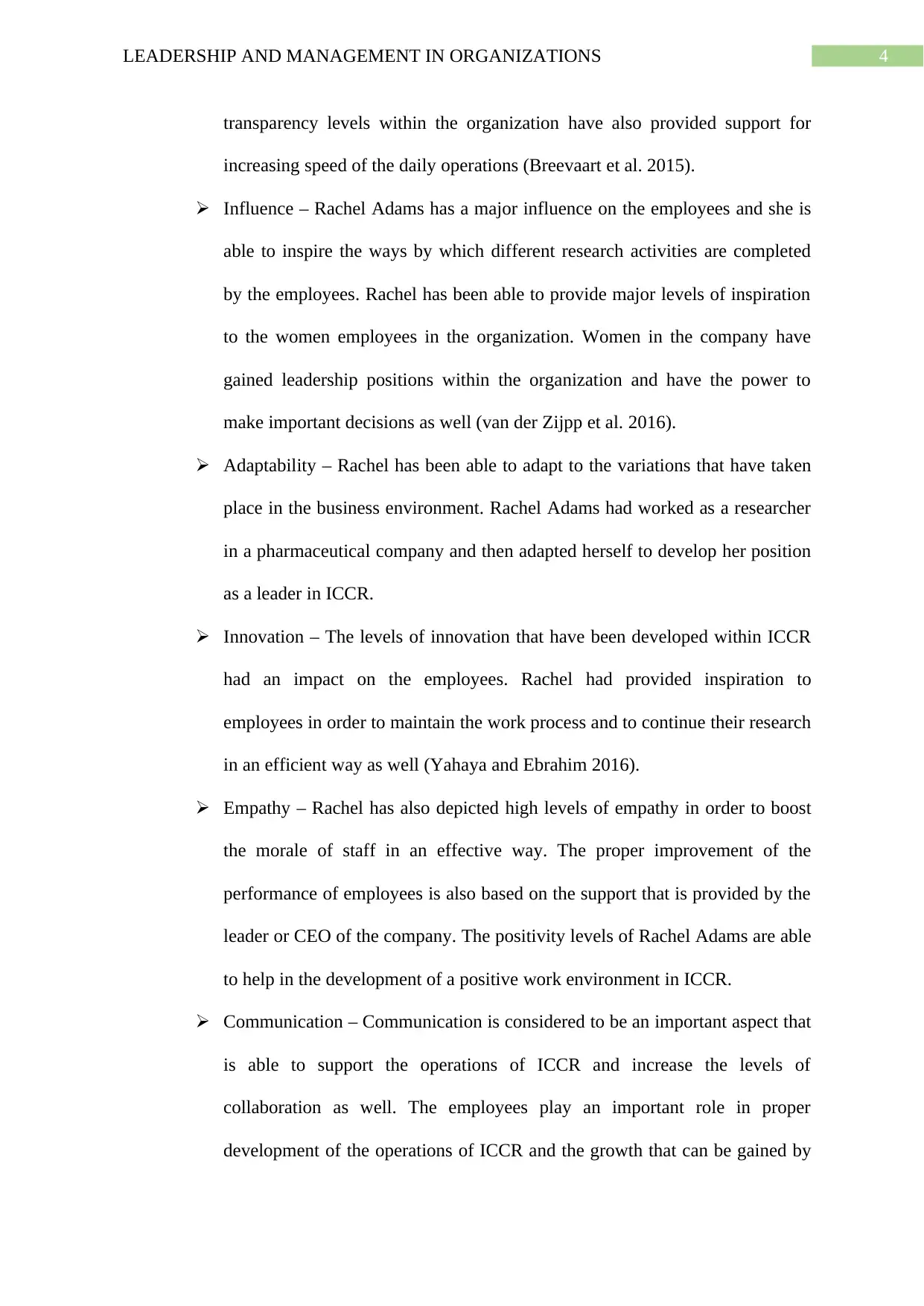
4LEADERSHIP AND MANAGEMENT IN ORGANIZATIONS
transparency levels within the organization have also provided support for
increasing speed of the daily operations (Breevaart et al. 2015).
Influence – Rachel Adams has a major influence on the employees and she is
able to inspire the ways by which different research activities are completed
by the employees. Rachel has been able to provide major levels of inspiration
to the women employees in the organization. Women in the company have
gained leadership positions within the organization and have the power to
make important decisions as well (van der Zijpp et al. 2016).
Adaptability – Rachel has been able to adapt to the variations that have taken
place in the business environment. Rachel Adams had worked as a researcher
in a pharmaceutical company and then adapted herself to develop her position
as a leader in ICCR.
Innovation – The levels of innovation that have been developed within ICCR
had an impact on the employees. Rachel had provided inspiration to
employees in order to maintain the work process and to continue their research
in an efficient way as well (Yahaya and Ebrahim 2016).
Empathy – Rachel has also depicted high levels of empathy in order to boost
the morale of staff in an effective way. The proper improvement of the
performance of employees is also based on the support that is provided by the
leader or CEO of the company. The positivity levels of Rachel Adams are able
to help in the development of a positive work environment in ICCR.
Communication – Communication is considered to be an important aspect that
is able to support the operations of ICCR and increase the levels of
collaboration as well. The employees play an important role in proper
development of the operations of ICCR and the growth that can be gained by
transparency levels within the organization have also provided support for
increasing speed of the daily operations (Breevaart et al. 2015).
Influence – Rachel Adams has a major influence on the employees and she is
able to inspire the ways by which different research activities are completed
by the employees. Rachel has been able to provide major levels of inspiration
to the women employees in the organization. Women in the company have
gained leadership positions within the organization and have the power to
make important decisions as well (van der Zijpp et al. 2016).
Adaptability – Rachel has been able to adapt to the variations that have taken
place in the business environment. Rachel Adams had worked as a researcher
in a pharmaceutical company and then adapted herself to develop her position
as a leader in ICCR.
Innovation – The levels of innovation that have been developed within ICCR
had an impact on the employees. Rachel had provided inspiration to
employees in order to maintain the work process and to continue their research
in an efficient way as well (Yahaya and Ebrahim 2016).
Empathy – Rachel has also depicted high levels of empathy in order to boost
the morale of staff in an effective way. The proper improvement of the
performance of employees is also based on the support that is provided by the
leader or CEO of the company. The positivity levels of Rachel Adams are able
to help in the development of a positive work environment in ICCR.
Communication – Communication is considered to be an important aspect that
is able to support the operations of ICCR and increase the levels of
collaboration as well. The employees play an important role in proper
development of the operations of ICCR and the growth that can be gained by
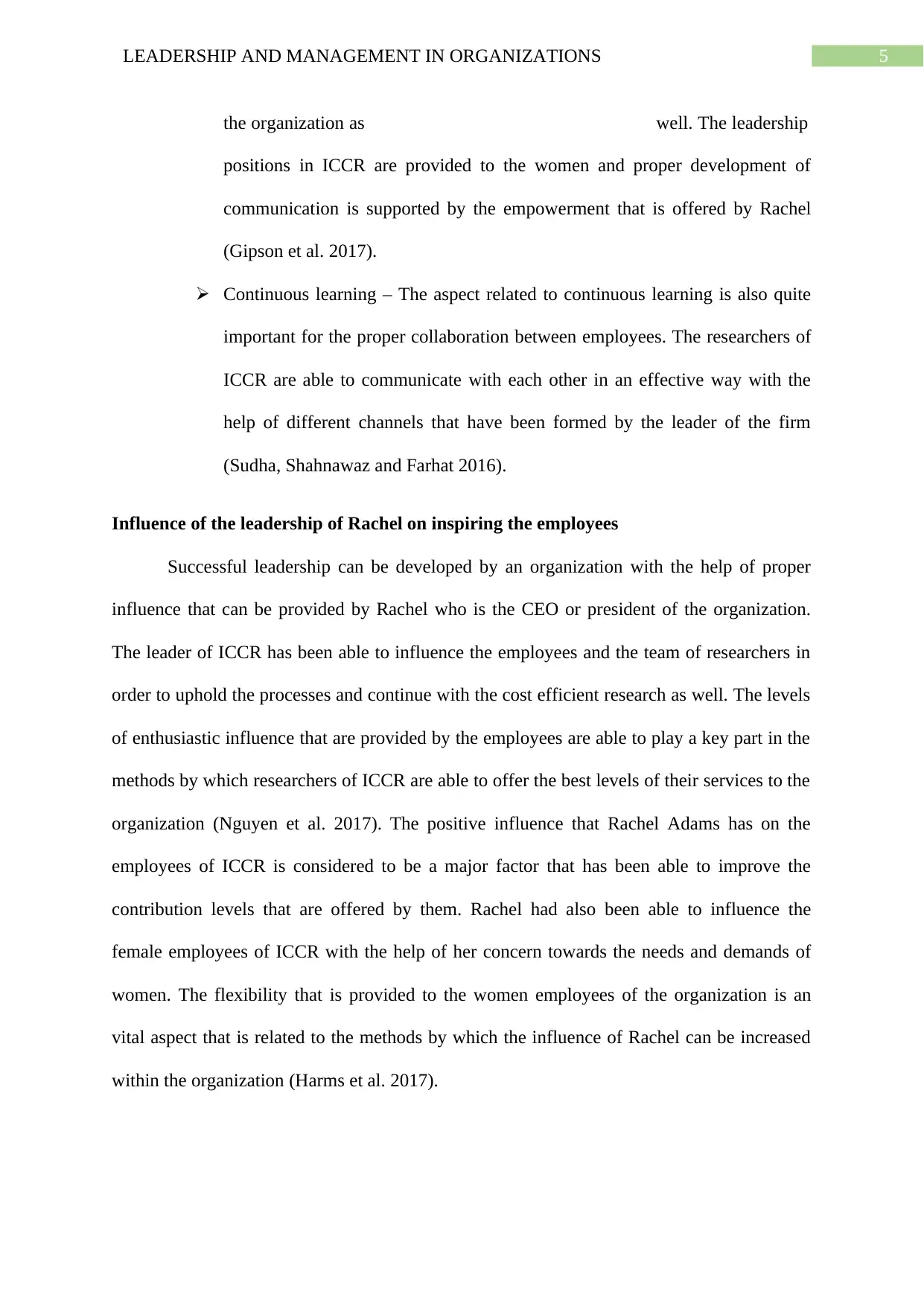
5LEADERSHIP AND MANAGEMENT IN ORGANIZATIONS
the organization as well. The leadership
positions in ICCR are provided to the women and proper development of
communication is supported by the empowerment that is offered by Rachel
(Gipson et al. 2017).
Continuous learning – The aspect related to continuous learning is also quite
important for the proper collaboration between employees. The researchers of
ICCR are able to communicate with each other in an effective way with the
help of different channels that have been formed by the leader of the firm
(Sudha, Shahnawaz and Farhat 2016).
Influence of the leadership of Rachel on inspiring the employees
Successful leadership can be developed by an organization with the help of proper
influence that can be provided by Rachel who is the CEO or president of the organization.
The leader of ICCR has been able to influence the employees and the team of researchers in
order to uphold the processes and continue with the cost efficient research as well. The levels
of enthusiastic influence that are provided by the employees are able to play a key part in the
methods by which researchers of ICCR are able to offer the best levels of their services to the
organization (Nguyen et al. 2017). The positive influence that Rachel Adams has on the
employees of ICCR is considered to be a major factor that has been able to improve the
contribution levels that are offered by them. Rachel had also been able to influence the
female employees of ICCR with the help of her concern towards the needs and demands of
women. The flexibility that is provided to the women employees of the organization is an
vital aspect that is related to the methods by which the influence of Rachel can be increased
within the organization (Harms et al. 2017).
the organization as well. The leadership
positions in ICCR are provided to the women and proper development of
communication is supported by the empowerment that is offered by Rachel
(Gipson et al. 2017).
Continuous learning – The aspect related to continuous learning is also quite
important for the proper collaboration between employees. The researchers of
ICCR are able to communicate with each other in an effective way with the
help of different channels that have been formed by the leader of the firm
(Sudha, Shahnawaz and Farhat 2016).
Influence of the leadership of Rachel on inspiring the employees
Successful leadership can be developed by an organization with the help of proper
influence that can be provided by Rachel who is the CEO or president of the organization.
The leader of ICCR has been able to influence the employees and the team of researchers in
order to uphold the processes and continue with the cost efficient research as well. The levels
of enthusiastic influence that are provided by the employees are able to play a key part in the
methods by which researchers of ICCR are able to offer the best levels of their services to the
organization (Nguyen et al. 2017). The positive influence that Rachel Adams has on the
employees of ICCR is considered to be a major factor that has been able to improve the
contribution levels that are offered by them. Rachel had also been able to influence the
female employees of ICCR with the help of her concern towards the needs and demands of
women. The flexibility that is provided to the women employees of the organization is an
vital aspect that is related to the methods by which the influence of Rachel can be increased
within the organization (Harms et al. 2017).
⊘ This is a preview!⊘
Do you want full access?
Subscribe today to unlock all pages.

Trusted by 1+ million students worldwide
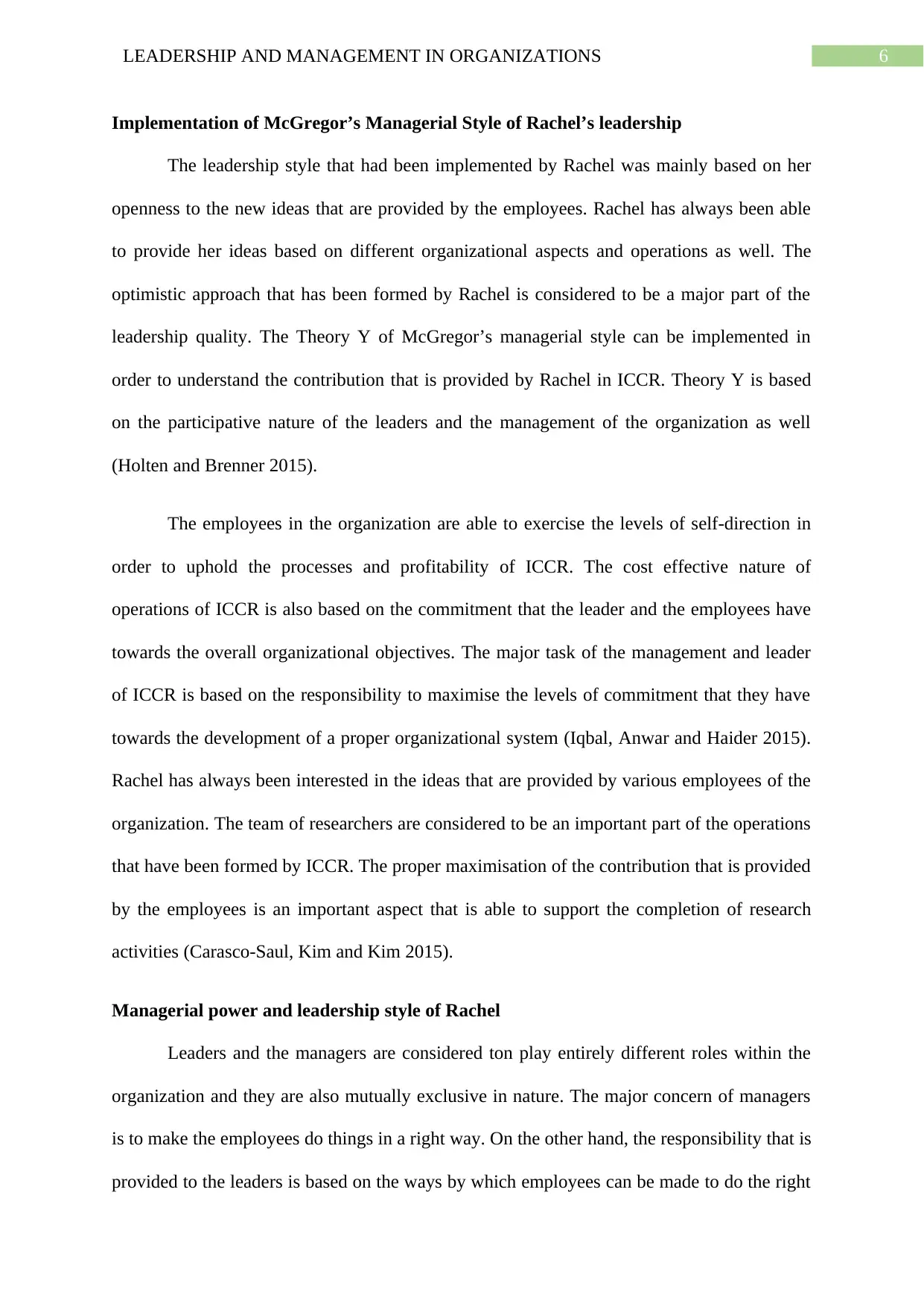
6LEADERSHIP AND MANAGEMENT IN ORGANIZATIONS
Implementation of McGregor’s Managerial Style of Rachel’s leadership
The leadership style that had been implemented by Rachel was mainly based on her
openness to the new ideas that are provided by the employees. Rachel has always been able
to provide her ideas based on different organizational aspects and operations as well. The
optimistic approach that has been formed by Rachel is considered to be a major part of the
leadership quality. The Theory Y of McGregor’s managerial style can be implemented in
order to understand the contribution that is provided by Rachel in ICCR. Theory Y is based
on the participative nature of the leaders and the management of the organization as well
(Holten and Brenner 2015).
The employees in the organization are able to exercise the levels of self-direction in
order to uphold the processes and profitability of ICCR. The cost effective nature of
operations of ICCR is also based on the commitment that the leader and the employees have
towards the overall organizational objectives. The major task of the management and leader
of ICCR is based on the responsibility to maximise the levels of commitment that they have
towards the development of a proper organizational system (Iqbal, Anwar and Haider 2015).
Rachel has always been interested in the ideas that are provided by various employees of the
organization. The team of researchers are considered to be an important part of the operations
that have been formed by ICCR. The proper maximisation of the contribution that is provided
by the employees is an important aspect that is able to support the completion of research
activities (Carasco-Saul, Kim and Kim 2015).
Managerial power and leadership style of Rachel
Leaders and the managers are considered ton play entirely different roles within the
organization and they are also mutually exclusive in nature. The major concern of managers
is to make the employees do things in a right way. On the other hand, the responsibility that is
provided to the leaders is based on the ways by which employees can be made to do the right
Implementation of McGregor’s Managerial Style of Rachel’s leadership
The leadership style that had been implemented by Rachel was mainly based on her
openness to the new ideas that are provided by the employees. Rachel has always been able
to provide her ideas based on different organizational aspects and operations as well. The
optimistic approach that has been formed by Rachel is considered to be a major part of the
leadership quality. The Theory Y of McGregor’s managerial style can be implemented in
order to understand the contribution that is provided by Rachel in ICCR. Theory Y is based
on the participative nature of the leaders and the management of the organization as well
(Holten and Brenner 2015).
The employees in the organization are able to exercise the levels of self-direction in
order to uphold the processes and profitability of ICCR. The cost effective nature of
operations of ICCR is also based on the commitment that the leader and the employees have
towards the overall organizational objectives. The major task of the management and leader
of ICCR is based on the responsibility to maximise the levels of commitment that they have
towards the development of a proper organizational system (Iqbal, Anwar and Haider 2015).
Rachel has always been interested in the ideas that are provided by various employees of the
organization. The team of researchers are considered to be an important part of the operations
that have been formed by ICCR. The proper maximisation of the contribution that is provided
by the employees is an important aspect that is able to support the completion of research
activities (Carasco-Saul, Kim and Kim 2015).
Managerial power and leadership style of Rachel
Leaders and the managers are considered ton play entirely different roles within the
organization and they are also mutually exclusive in nature. The major concern of managers
is to make the employees do things in a right way. On the other hand, the responsibility that is
provided to the leaders is based on the ways by which employees can be made to do the right
Paraphrase This Document
Need a fresh take? Get an instant paraphrase of this document with our AI Paraphraser
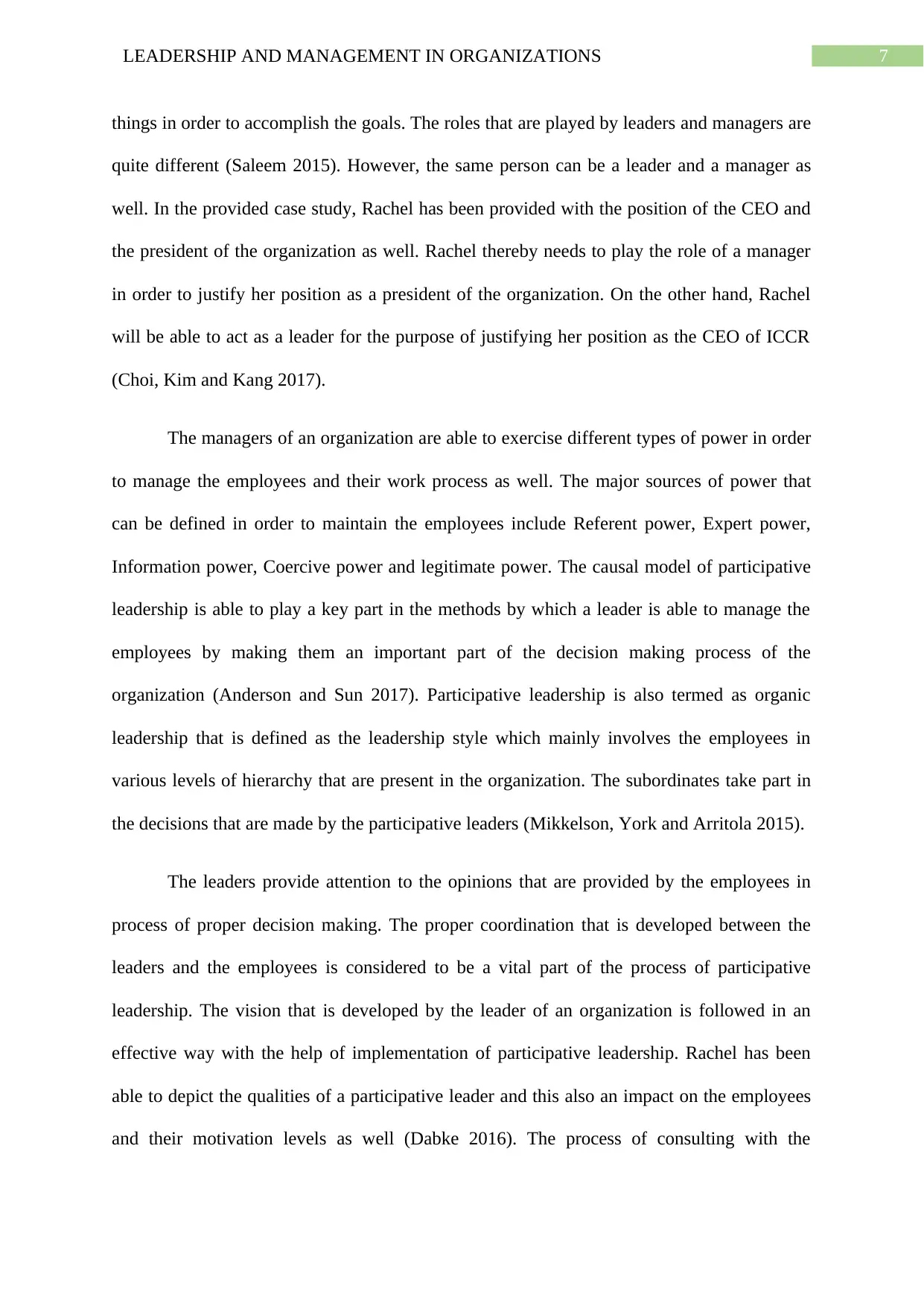
7LEADERSHIP AND MANAGEMENT IN ORGANIZATIONS
things in order to accomplish the goals. The roles that are played by leaders and managers are
quite different (Saleem 2015). However, the same person can be a leader and a manager as
well. In the provided case study, Rachel has been provided with the position of the CEO and
the president of the organization as well. Rachel thereby needs to play the role of a manager
in order to justify her position as a president of the organization. On the other hand, Rachel
will be able to act as a leader for the purpose of justifying her position as the CEO of ICCR
(Choi, Kim and Kang 2017).
The managers of an organization are able to exercise different types of power in order
to manage the employees and their work process as well. The major sources of power that
can be defined in order to maintain the employees include Referent power, Expert power,
Information power, Coercive power and legitimate power. The causal model of participative
leadership is able to play a key part in the methods by which a leader is able to manage the
employees by making them an important part of the decision making process of the
organization (Anderson and Sun 2017). Participative leadership is also termed as organic
leadership that is defined as the leadership style which mainly involves the employees in
various levels of hierarchy that are present in the organization. The subordinates take part in
the decisions that are made by the participative leaders (Mikkelson, York and Arritola 2015).
The leaders provide attention to the opinions that are provided by the employees in
process of proper decision making. The proper coordination that is developed between the
leaders and the employees is considered to be a vital part of the process of participative
leadership. The vision that is developed by the leader of an organization is followed in an
effective way with the help of implementation of participative leadership. Rachel has been
able to depict the qualities of a participative leader and this also an impact on the employees
and their motivation levels as well (Dabke 2016). The process of consulting with the
things in order to accomplish the goals. The roles that are played by leaders and managers are
quite different (Saleem 2015). However, the same person can be a leader and a manager as
well. In the provided case study, Rachel has been provided with the position of the CEO and
the president of the organization as well. Rachel thereby needs to play the role of a manager
in order to justify her position as a president of the organization. On the other hand, Rachel
will be able to act as a leader for the purpose of justifying her position as the CEO of ICCR
(Choi, Kim and Kang 2017).
The managers of an organization are able to exercise different types of power in order
to manage the employees and their work process as well. The major sources of power that
can be defined in order to maintain the employees include Referent power, Expert power,
Information power, Coercive power and legitimate power. The causal model of participative
leadership is able to play a key part in the methods by which a leader is able to manage the
employees by making them an important part of the decision making process of the
organization (Anderson and Sun 2017). Participative leadership is also termed as organic
leadership that is defined as the leadership style which mainly involves the employees in
various levels of hierarchy that are present in the organization. The subordinates take part in
the decisions that are made by the participative leaders (Mikkelson, York and Arritola 2015).
The leaders provide attention to the opinions that are provided by the employees in
process of proper decision making. The proper coordination that is developed between the
leaders and the employees is considered to be a vital part of the process of participative
leadership. The vision that is developed by the leader of an organization is followed in an
effective way with the help of implementation of participative leadership. Rachel has been
able to depict the qualities of a participative leader and this also an impact on the employees
and their motivation levels as well (Dabke 2016). The process of consulting with the
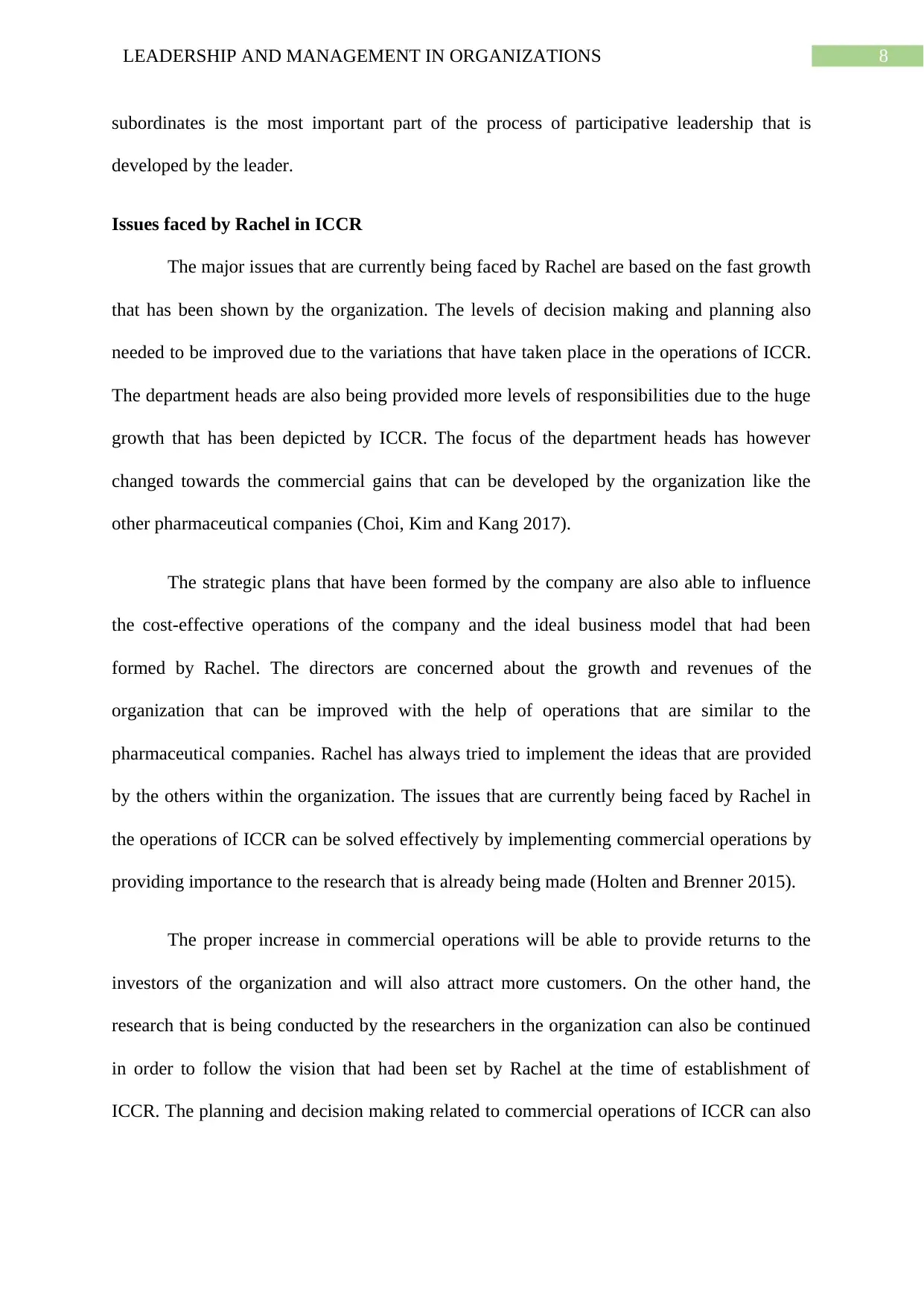
8LEADERSHIP AND MANAGEMENT IN ORGANIZATIONS
subordinates is the most important part of the process of participative leadership that is
developed by the leader.
Issues faced by Rachel in ICCR
The major issues that are currently being faced by Rachel are based on the fast growth
that has been shown by the organization. The levels of decision making and planning also
needed to be improved due to the variations that have taken place in the operations of ICCR.
The department heads are also being provided more levels of responsibilities due to the huge
growth that has been depicted by ICCR. The focus of the department heads has however
changed towards the commercial gains that can be developed by the organization like the
other pharmaceutical companies (Choi, Kim and Kang 2017).
The strategic plans that have been formed by the company are also able to influence
the cost-effective operations of the company and the ideal business model that had been
formed by Rachel. The directors are concerned about the growth and revenues of the
organization that can be improved with the help of operations that are similar to the
pharmaceutical companies. Rachel has always tried to implement the ideas that are provided
by the others within the organization. The issues that are currently being faced by Rachel in
the operations of ICCR can be solved effectively by implementing commercial operations by
providing importance to the research that is already being made (Holten and Brenner 2015).
The proper increase in commercial operations will be able to provide returns to the
investors of the organization and will also attract more customers. On the other hand, the
research that is being conducted by the researchers in the organization can also be continued
in order to follow the vision that had been set by Rachel at the time of establishment of
ICCR. The planning and decision making related to commercial operations of ICCR can also
subordinates is the most important part of the process of participative leadership that is
developed by the leader.
Issues faced by Rachel in ICCR
The major issues that are currently being faced by Rachel are based on the fast growth
that has been shown by the organization. The levels of decision making and planning also
needed to be improved due to the variations that have taken place in the operations of ICCR.
The department heads are also being provided more levels of responsibilities due to the huge
growth that has been depicted by ICCR. The focus of the department heads has however
changed towards the commercial gains that can be developed by the organization like the
other pharmaceutical companies (Choi, Kim and Kang 2017).
The strategic plans that have been formed by the company are also able to influence
the cost-effective operations of the company and the ideal business model that had been
formed by Rachel. The directors are concerned about the growth and revenues of the
organization that can be improved with the help of operations that are similar to the
pharmaceutical companies. Rachel has always tried to implement the ideas that are provided
by the others within the organization. The issues that are currently being faced by Rachel in
the operations of ICCR can be solved effectively by implementing commercial operations by
providing importance to the research that is already being made (Holten and Brenner 2015).
The proper increase in commercial operations will be able to provide returns to the
investors of the organization and will also attract more customers. On the other hand, the
research that is being conducted by the researchers in the organization can also be continued
in order to follow the vision that had been set by Rachel at the time of establishment of
ICCR. The planning and decision making related to commercial operations of ICCR can also
⊘ This is a preview!⊘
Do you want full access?
Subscribe today to unlock all pages.

Trusted by 1+ million students worldwide
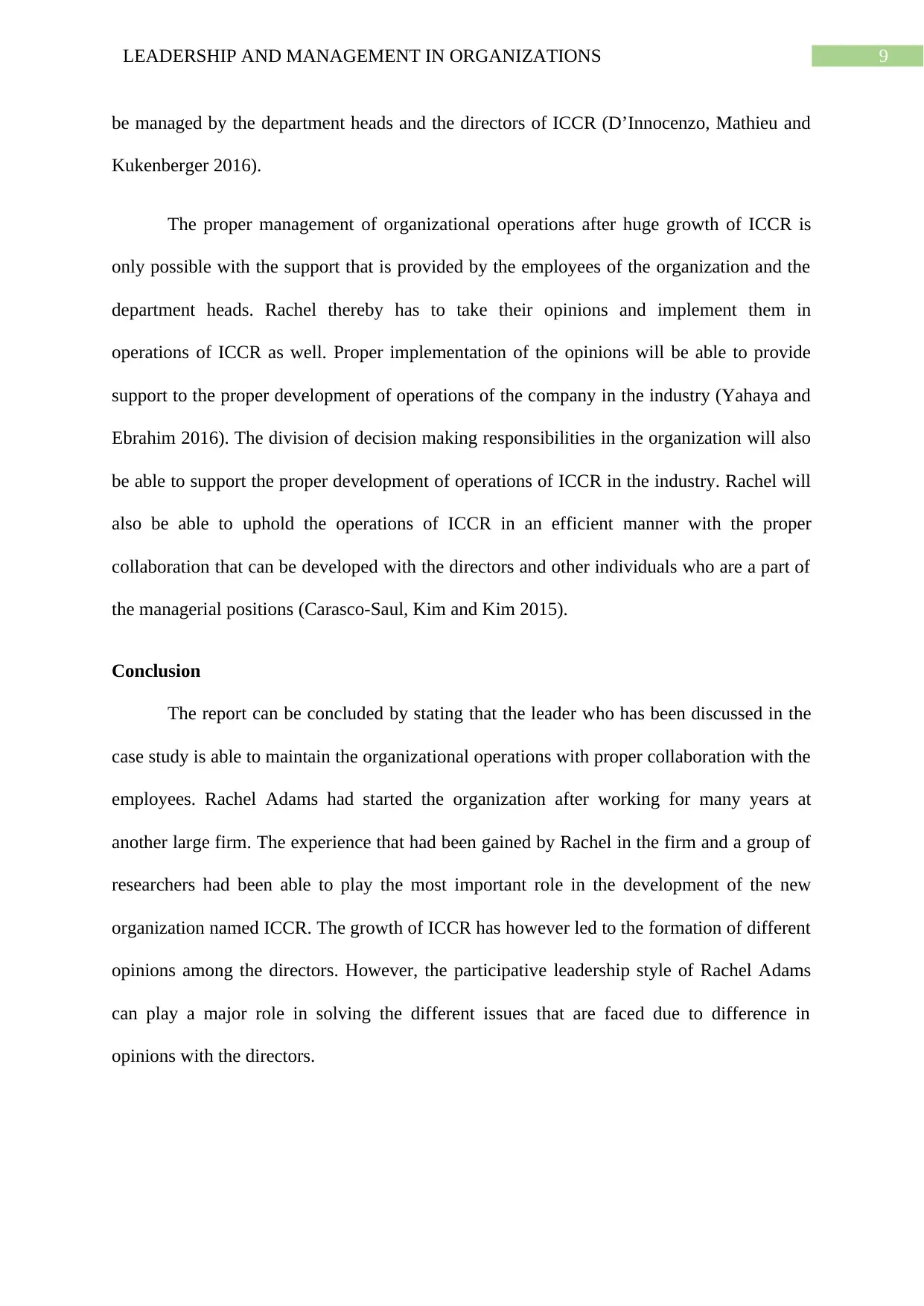
9LEADERSHIP AND MANAGEMENT IN ORGANIZATIONS
be managed by the department heads and the directors of ICCR (D’Innocenzo, Mathieu and
Kukenberger 2016).
The proper management of organizational operations after huge growth of ICCR is
only possible with the support that is provided by the employees of the organization and the
department heads. Rachel thereby has to take their opinions and implement them in
operations of ICCR as well. Proper implementation of the opinions will be able to provide
support to the proper development of operations of the company in the industry (Yahaya and
Ebrahim 2016). The division of decision making responsibilities in the organization will also
be able to support the proper development of operations of ICCR in the industry. Rachel will
also be able to uphold the operations of ICCR in an efficient manner with the proper
collaboration that can be developed with the directors and other individuals who are a part of
the managerial positions (Carasco-Saul, Kim and Kim 2015).
Conclusion
The report can be concluded by stating that the leader who has been discussed in the
case study is able to maintain the organizational operations with proper collaboration with the
employees. Rachel Adams had started the organization after working for many years at
another large firm. The experience that had been gained by Rachel in the firm and a group of
researchers had been able to play the most important role in the development of the new
organization named ICCR. The growth of ICCR has however led to the formation of different
opinions among the directors. However, the participative leadership style of Rachel Adams
can play a major role in solving the different issues that are faced due to difference in
opinions with the directors.
be managed by the department heads and the directors of ICCR (D’Innocenzo, Mathieu and
Kukenberger 2016).
The proper management of organizational operations after huge growth of ICCR is
only possible with the support that is provided by the employees of the organization and the
department heads. Rachel thereby has to take their opinions and implement them in
operations of ICCR as well. Proper implementation of the opinions will be able to provide
support to the proper development of operations of the company in the industry (Yahaya and
Ebrahim 2016). The division of decision making responsibilities in the organization will also
be able to support the proper development of operations of ICCR in the industry. Rachel will
also be able to uphold the operations of ICCR in an efficient manner with the proper
collaboration that can be developed with the directors and other individuals who are a part of
the managerial positions (Carasco-Saul, Kim and Kim 2015).
Conclusion
The report can be concluded by stating that the leader who has been discussed in the
case study is able to maintain the organizational operations with proper collaboration with the
employees. Rachel Adams had started the organization after working for many years at
another large firm. The experience that had been gained by Rachel in the firm and a group of
researchers had been able to play the most important role in the development of the new
organization named ICCR. The growth of ICCR has however led to the formation of different
opinions among the directors. However, the participative leadership style of Rachel Adams
can play a major role in solving the different issues that are faced due to difference in
opinions with the directors.
Paraphrase This Document
Need a fresh take? Get an instant paraphrase of this document with our AI Paraphraser
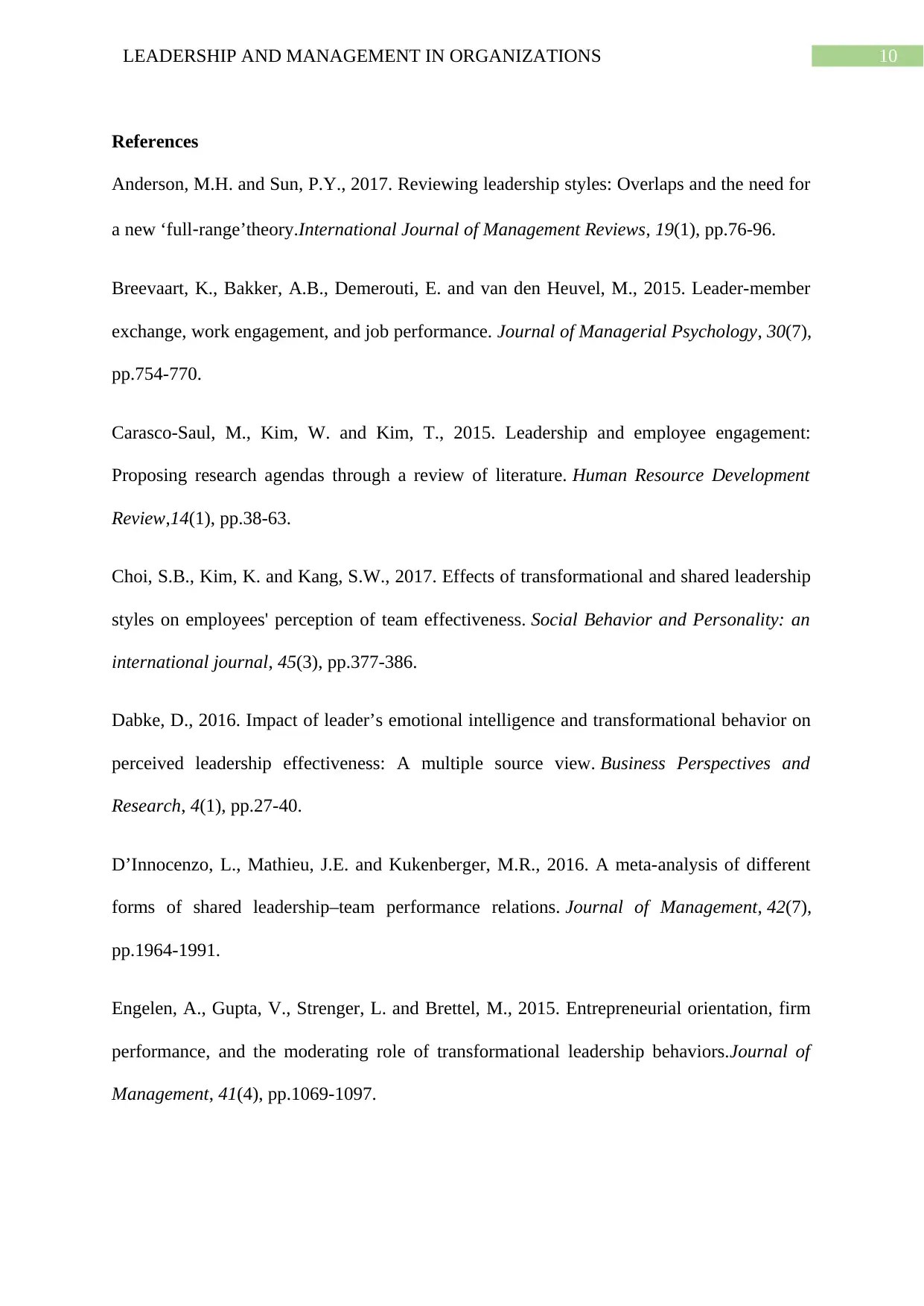
10LEADERSHIP AND MANAGEMENT IN ORGANIZATIONS
References
Anderson, M.H. and Sun, P.Y., 2017. Reviewing leadership styles: Overlaps and the need for
a new ‘full‐range’theory.International Journal of Management Reviews, 19(1), pp.76-96.
Breevaart, K., Bakker, A.B., Demerouti, E. and van den Heuvel, M., 2015. Leader-member
exchange, work engagement, and job performance. Journal of Managerial Psychology, 30(7),
pp.754-770.
Carasco-Saul, M., Kim, W. and Kim, T., 2015. Leadership and employee engagement:
Proposing research agendas through a review of literature. Human Resource Development
Review,14(1), pp.38-63.
Choi, S.B., Kim, K. and Kang, S.W., 2017. Effects of transformational and shared leadership
styles on employees' perception of team effectiveness. Social Behavior and Personality: an
international journal, 45(3), pp.377-386.
Dabke, D., 2016. Impact of leader’s emotional intelligence and transformational behavior on
perceived leadership effectiveness: A multiple source view. Business Perspectives and
Research, 4(1), pp.27-40.
D’Innocenzo, L., Mathieu, J.E. and Kukenberger, M.R., 2016. A meta-analysis of different
forms of shared leadership–team performance relations. Journal of Management, 42(7),
pp.1964-1991.
Engelen, A., Gupta, V., Strenger, L. and Brettel, M., 2015. Entrepreneurial orientation, firm
performance, and the moderating role of transformational leadership behaviors.Journal of
Management, 41(4), pp.1069-1097.
References
Anderson, M.H. and Sun, P.Y., 2017. Reviewing leadership styles: Overlaps and the need for
a new ‘full‐range’theory.International Journal of Management Reviews, 19(1), pp.76-96.
Breevaart, K., Bakker, A.B., Demerouti, E. and van den Heuvel, M., 2015. Leader-member
exchange, work engagement, and job performance. Journal of Managerial Psychology, 30(7),
pp.754-770.
Carasco-Saul, M., Kim, W. and Kim, T., 2015. Leadership and employee engagement:
Proposing research agendas through a review of literature. Human Resource Development
Review,14(1), pp.38-63.
Choi, S.B., Kim, K. and Kang, S.W., 2017. Effects of transformational and shared leadership
styles on employees' perception of team effectiveness. Social Behavior and Personality: an
international journal, 45(3), pp.377-386.
Dabke, D., 2016. Impact of leader’s emotional intelligence and transformational behavior on
perceived leadership effectiveness: A multiple source view. Business Perspectives and
Research, 4(1), pp.27-40.
D’Innocenzo, L., Mathieu, J.E. and Kukenberger, M.R., 2016. A meta-analysis of different
forms of shared leadership–team performance relations. Journal of Management, 42(7),
pp.1964-1991.
Engelen, A., Gupta, V., Strenger, L. and Brettel, M., 2015. Entrepreneurial orientation, firm
performance, and the moderating role of transformational leadership behaviors.Journal of
Management, 41(4), pp.1069-1097.
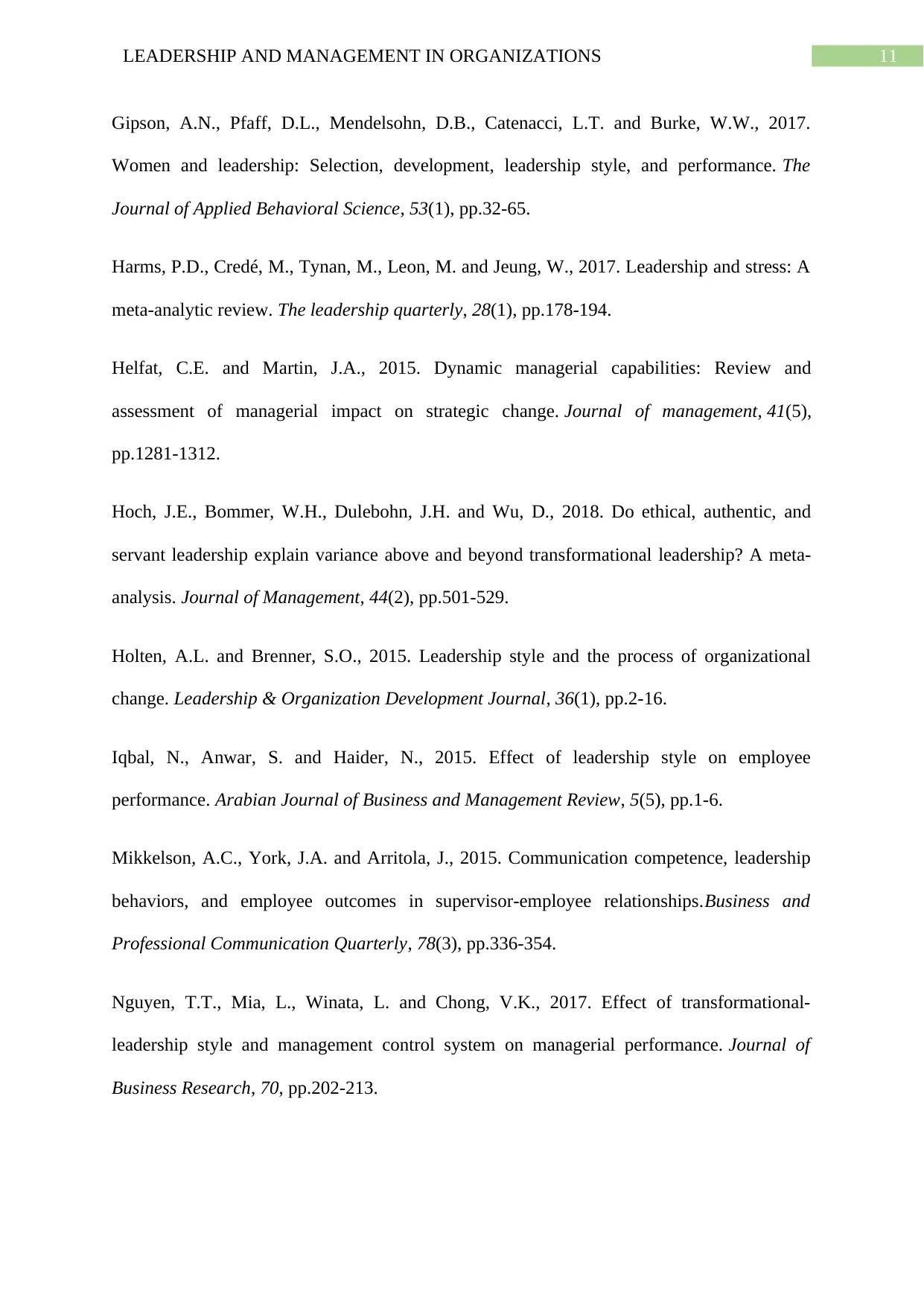
11LEADERSHIP AND MANAGEMENT IN ORGANIZATIONS
Gipson, A.N., Pfaff, D.L., Mendelsohn, D.B., Catenacci, L.T. and Burke, W.W., 2017.
Women and leadership: Selection, development, leadership style, and performance. The
Journal of Applied Behavioral Science, 53(1), pp.32-65.
Harms, P.D., Credé, M., Tynan, M., Leon, M. and Jeung, W., 2017. Leadership and stress: A
meta-analytic review. The leadership quarterly, 28(1), pp.178-194.
Helfat, C.E. and Martin, J.A., 2015. Dynamic managerial capabilities: Review and
assessment of managerial impact on strategic change. Journal of management, 41(5),
pp.1281-1312.
Hoch, J.E., Bommer, W.H., Dulebohn, J.H. and Wu, D., 2018. Do ethical, authentic, and
servant leadership explain variance above and beyond transformational leadership? A meta-
analysis. Journal of Management, 44(2), pp.501-529.
Holten, A.L. and Brenner, S.O., 2015. Leadership style and the process of organizational
change. Leadership & Organization Development Journal, 36(1), pp.2-16.
Iqbal, N., Anwar, S. and Haider, N., 2015. Effect of leadership style on employee
performance. Arabian Journal of Business and Management Review, 5(5), pp.1-6.
Mikkelson, A.C., York, J.A. and Arritola, J., 2015. Communication competence, leadership
behaviors, and employee outcomes in supervisor-employee relationships.Business and
Professional Communication Quarterly, 78(3), pp.336-354.
Nguyen, T.T., Mia, L., Winata, L. and Chong, V.K., 2017. Effect of transformational-
leadership style and management control system on managerial performance. Journal of
Business Research, 70, pp.202-213.
Gipson, A.N., Pfaff, D.L., Mendelsohn, D.B., Catenacci, L.T. and Burke, W.W., 2017.
Women and leadership: Selection, development, leadership style, and performance. The
Journal of Applied Behavioral Science, 53(1), pp.32-65.
Harms, P.D., Credé, M., Tynan, M., Leon, M. and Jeung, W., 2017. Leadership and stress: A
meta-analytic review. The leadership quarterly, 28(1), pp.178-194.
Helfat, C.E. and Martin, J.A., 2015. Dynamic managerial capabilities: Review and
assessment of managerial impact on strategic change. Journal of management, 41(5),
pp.1281-1312.
Hoch, J.E., Bommer, W.H., Dulebohn, J.H. and Wu, D., 2018. Do ethical, authentic, and
servant leadership explain variance above and beyond transformational leadership? A meta-
analysis. Journal of Management, 44(2), pp.501-529.
Holten, A.L. and Brenner, S.O., 2015. Leadership style and the process of organizational
change. Leadership & Organization Development Journal, 36(1), pp.2-16.
Iqbal, N., Anwar, S. and Haider, N., 2015. Effect of leadership style on employee
performance. Arabian Journal of Business and Management Review, 5(5), pp.1-6.
Mikkelson, A.C., York, J.A. and Arritola, J., 2015. Communication competence, leadership
behaviors, and employee outcomes in supervisor-employee relationships.Business and
Professional Communication Quarterly, 78(3), pp.336-354.
Nguyen, T.T., Mia, L., Winata, L. and Chong, V.K., 2017. Effect of transformational-
leadership style and management control system on managerial performance. Journal of
Business Research, 70, pp.202-213.
⊘ This is a preview!⊘
Do you want full access?
Subscribe today to unlock all pages.

Trusted by 1+ million students worldwide
1 out of 13
Related Documents
Your All-in-One AI-Powered Toolkit for Academic Success.
+13062052269
info@desklib.com
Available 24*7 on WhatsApp / Email
![[object Object]](/_next/static/media/star-bottom.7253800d.svg)
Unlock your academic potential
Copyright © 2020–2025 A2Z Services. All Rights Reserved. Developed and managed by ZUCOL.




